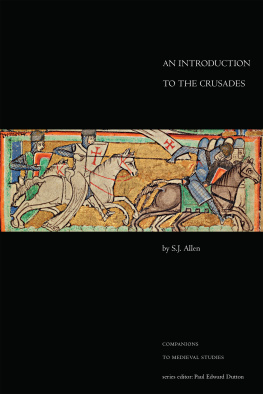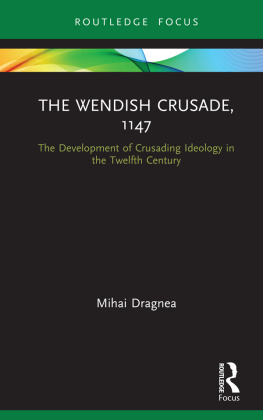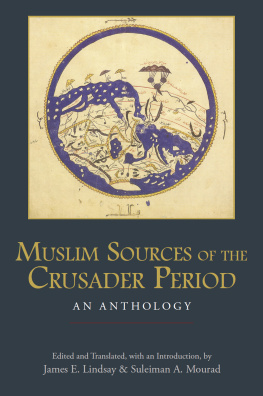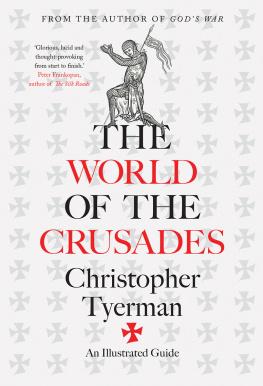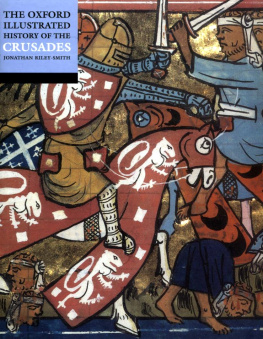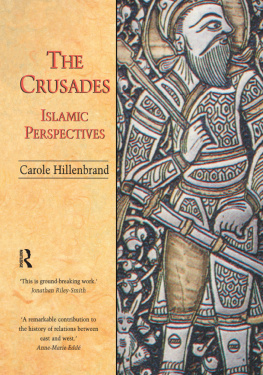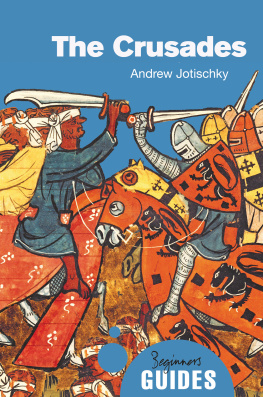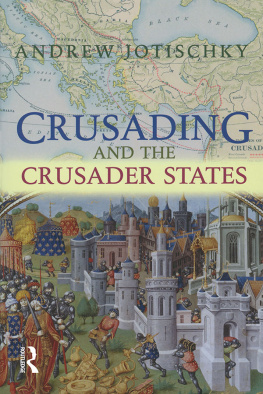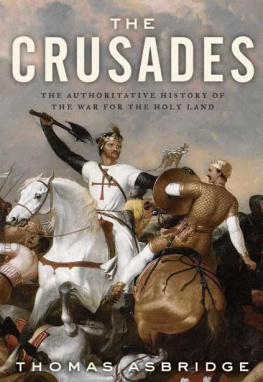AN INTRODUCTION TO THE CRUSADES
S.J. Allen

Copyright University of Toronto Press 2017
Higher Education Division
www.utppublishing.com
All rights reserved. The use of any part of this publication reproduced, transmitted in any form or by any means, electronic, mechanical, photocopying, recording, or otherwise, or stored in a retrieval system, without prior written consent of the publisheror in the case of photocopying, a licence from Access Copyright (the Canadian Copyright Licensing Agency), 32056 Wellesley Street West, Toronto, Ontario, m5s 2s3is an infringement of the copyright law.
Allen, S.J. (Susan Jane), 1959, author
An introduction to the crusades/S.J. Allen.
(Companions to medieval studies series)
Includes bibliographical references and index.
Issued in print and electronic formats.
ISBN 978-1-4426-0023-2 (softcover).ISBN 978-1-4426-0024-9 (hardcover). ISBN 978-1-4426-0027-0 (HTML).ISBN 978-1-4426-0025-6 (PDF)
1. Crusades. I. Title. II. Series: Companions to medieval studies series.
D151.C76 2017 909.07 C2017-902666-6
C2017-902667-4
We welcome comments and suggestions regarding any aspect of our publications please feel free to contact us at .
North America
5201 Dufferin Street
North York, Ontario, Canada, m3h 5t8
2250 Military Road
Tonawanda, New York, USA, 14150
orders phone : 1-800-565-9523
orders fax : 1-800-221-9985
orders e-mail :
UK, Ireland, and continental Europe
NBN International
Estover Road, Plymouth, pl6 7py , UK
orders phone : 44 (0) 1752 202301
orders fax : 44 (0) 1752 202333
orders e-mail :
Every effort has been made to contact copyright holders; in the event of an error or omission, please notify the publisher.
Maps by Robert Cronan of Lucidity Information Design
The University of Toronto Press acknowledges the financial support for its publishing activities of the Government of Canada through the Canada Book Fund.
Printed in the United States of America.
For Emilie Amt
ILLUSTRATIONS AND MAPS
Illustrations
Maps
ACKNOWLEDGMENTS
I am indebted to the University of Toronto Press for the opportunity to write this companion book to The Crusades: A Reader, second edition. I am especially grateful for the support and guidance provided by the Series Editor, Paul Edward Dutton, UTPs History Editor, Natalie Fingerhut, and copy editor Martin Boyne. This book would simply not have been possible without their professional direction and sympathetic assistance. Any shortcomings of the work are, of course, my own. I would also like to offer my heartfelt thanks to the University of Toronto Press production team, especially for their work on the books index, maps, and illustrations. The Open University Library staff were instrumental in the research stage of the book, as was my Crusades reader co-editor, Emilie Amt. Finally, particular thanks must be given to my son Giles for his encouragement and patience and to my husband Stephen, whose British civil-service skills proved invaluable on more than one occasion during the writing of An Introduction to the Crusades.
PREFACE
The word crusade conjures up an array of conflicting images and emotions. Popular impressions of this movement range from that of a chivalric expression of piety to a violent example of human greed and intolerance. Modern curiosity about the Crusades owes much to our post-9/11 world and the current dialogues and tensions surrounding western and Islamic ideologies.
Our early twenty-first century has seen popular interest in the Crusades matched by a corresponding surge of academic research. The ideas put forward by professional historians, however, are often found to be in conflict with the views of the general public. This is perhaps understandable, given the density of current crusade scholarship and the prevalence of romantic or overtly political interpretations of the movement. The Crusades perceived significance to todays society was emphasized in the Preface to The Crusades: A Reader, second edition (which Emilie Amt and I edited): It could be argued that the Crusades, more than any other medieval event, have become inextricably linked to present-day political and religious debates (: xii). Whether popular or academic, it is true to say that never before has this movement received such widespread attention and deliberation.
An Introduction to the Crusades, as part of the Companions to Medieval Studies series, aims to provide students with a concise introduction to the subject and to current discussions and debates within crusade studies. It has been designed as an interactive text, with opportunities to engage with original source material while developing a critical approach to the period and its events. To this end, An Introduction to the Crusades contextualizes many of the primary documents found in the companion sourcebook, The Crusades: A Reader, second edition. Although the Introduction can be read as a stand-alone work, its use with the Reader should lead to a deeper appreciation of the subject and its related issues.
As with any academic study, the Crusades generate intense debate among scholars concerning their origins, development, and import. Therefore, a key objective of this volume is to raise awareness not only of how this history has been constructed, but also of the means by which it continues to be reviewed and evaluated. Efforts have been made to encourage students to assess and reinterpret both primary evidence and secondary research, with the aim of generating a better understanding of the material and the historical problems associated with the topic.
Place and Person Names
All names are anglicized with the aim of providing the most common English spellings. Please be aware, however, that quoted sources may exhibit some variation.
In-text References
References to primary documents in The Crusades: A Reader are given as CR, preceded by the title of the document as it appears in the reader. References to secondary sources are in a shortened in-text style, with the full citation appearing in the Bibliography at the end of the book.
ABBREVIATIONS
| BCE/CE | Before the Common Era/Common Era (the modern alternative to BC and AD). Dates without an abbreviation should be read as CE. |
| CR | The Crusades: A Reader, second edition (2014) |
| ca | circa, about; approximately (indicating that the exact dates are not known) |
| fl. | floruit, flourished (indicating that exact dates of a persons life are uncertain or signifying the period when the person was most active) |
| r. | reign or tenure of office (indicating the ruling dates of a king, emperor, caliph, sultan, pope, or other leader) |
| d. | died (used if only the date of death is known) |
| b. | born (used if the person referred to is still living at the time of the works publication) |

